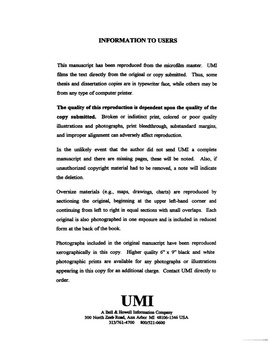| dc.contributor.advisor | McKnight, Curtis C., | en_US |
| dc.contributor.author | Bergthold, Trisha A. | en_US |
| dc.date.accessioned | 2013-08-16T12:30:28Z | |
| dc.date.available | 2013-08-16T12:30:28Z | |
| dc.date.issued | 1999 | en_US |
| dc.identifier.uri | https://hdl.handle.net/11244/5780 | |
| dc.description.abstract | This study explored first-semester calculus students' early understanding of limits, relative to their function knowledge and graphing calculator use. The purpose was to identify and describe students' patterns of analytical thinking and knowledge use in determining limit situations, as a first step in developing a grounded theory of early development of intuitive limit concepts. | en_US |
| dc.description.abstract | Students in this study had difficulty determining local function behavior, and did not always connect this to determining limit situations. They could read graphs and tables to conjecture limits, but often based such conjectures on poor tables or graphs. They learned that tables and graphs might mislead them, but rarely analyzed this, either assuming representativeness or assuming they were being misled. These students relied on formula-based expectations, graphs, or a few function values in determining limit situations. They did not know how to move from "almost certain" to certain in determining a limit situation. | en_US |
| dc.description.abstract | Over four task-based interviews, ten students progressed from examining local function behavior to analyzing increasingly difficult limit situations. Written and oral responses were analyzed relative to a four-element framework developed by the author: (a) analyzing functions locally in graphical and numerical settings; (b) conjecturing limits from representative graphs and tables; (c) understanding advantages and limitations of tables and graphs to conjecturing limits, particularly when using graphing calculators; and (d) producing multiple sources of evidence to justify a limit conjecture, and knowing whether this evidence is sufficient. Students demonstrating these four elements were deemed to have an intuitive-analytic understanding of the limit concept. | en_US |
| dc.description.abstract | The graphing calculator played a significant role. Graphs and tables on the calculator were often taken as the "standard" of comparison, without analysis. Awareness of calculator limitations did not necessarily imply correct limit conjectures, due to ignoring the limitations, or erroneously assuming the effects of those limitations. | en_US |
| dc.description.abstract | These students' function knowledge and methods of analyzing local function behavior both did and did not influence their determination of limit situations. Partial analyses led them to accept non-representative behavior, which led to erroneous limit conjectures. On the other hand, even full and complete analyses did not always result in correct limit conjectures. | en_US |
| dc.format.extent | x, 162 leaves : | en_US |
| dc.subject | Psychology, Cognitive. | en_US |
| dc.subject | Education, Mathematics. | en_US |
| dc.subject | Education, Educational Psychology. | en_US |
| dc.subject | Calculus Study and teaching. | en_US |
| dc.title | Patterns of analytical thinking and knowledge use in students' early understanding of the limit concept. | en_US |
| dc.type | Thesis | en_US |
| dc.thesis.degree | Ph.D. | en_US |
| dc.thesis.degreeDiscipline | Department of Mathematics | en_US |
| dc.note | Source: Dissertation Abstracts International, Volume: 60-04, Section: A, page: 1054. | en_US |
| dc.note | Adviser: Curtis C. McKnight. | en_US |
| ou.identifier | (UMI)AAI9925593 | en_US |
| ou.group | College of Arts and Sciences::Department of Mathematics | |
